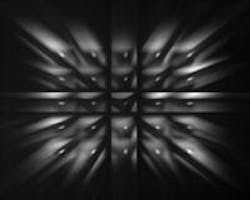All-reflective spatial and spectral imager improves UV and IR capability
Hyperspectral imaging plays a critical role in determining spectral and spatial information of a scene; for example, in applications such as pharmaceutical identification and satellite or aerial surveys of vegetation and industrial scenes. The process of simultaneously acquiring spatial and spectral information about a scene is called snapshot hyperspectral imaging (SHI). Ideal SHI is realized through a computed-tomography imaging spectrometer (CTIS), a system that records spectral and spatial information by imaging a scene through an optical system that has a 2-D grating disperser in the path of the collimated image. This grating produces multiple, spectrally dispersed images of a scene that are simultaneously recorded on a focal-plane-array (FPA) detector.
Scientists at the Jet Propulsion Laboratory (JPL; Pasadena, CA) have constructed and demonstrated an all-reflective Offner-type CTIS using a 2-D computer-generated hologram (CGH) as the grating disperser.1 Using standard electron-beam lithography, their reflective 2-D CGH was fabricated, for what they believe to be the first time, on a convex substrate-an innovation necessary to realize the all-reflective Offner CTIS design. The Offner-type reflective design is ideal for use in the UV and IR regions compared to earlier transmissive designs, and eliminates refractive system deficiencies such as bulky and expensive lens assemblies and multiband chromatic errors, and has overall higher efficiency (greater than 70%).
Reconfigurable field stop
Another innovation in the JPL CTIS system is the use of a reconfigurable reflective field stop that allows selective directional reflection of an incident-scene image by electrostatic tilting of microsize mirrors using a commercially available digital micromirror device (DMD). During full-frame operation of the CTIS, the DMD allows the system to be reconfigured into a high-spectral-resolution point spectrometer for regions of interest in the scene. Each mirror of the microelectromechanical system (MEMS) is individually addressable and controlled by an electric potential that causes +12° to -12° of tilt.
The CGH grating was designed for broadband use in a 5 × 5 diffraction-order configuration, with order efficiency highest for the outermost dispersed orders and lowest for the inner orders, which ensures that after dispersion, the image signal on the FPA is equivalent for all orders. The CGH depth pattern was fabricated by analog direct-write electron-beam lithography in polymethyl methacrylate resist on a convex diamond-turned substrate. With a 10 × 16-pixel format, each pixel is 6 × 5 µm with a maximum depth of 0.56 µm. Overall, the Offner system was optimized for visible to near-IR wavelengths from 600 to 1000 nm with 5-nm bands.
The researchers demonstrated operation of their CTIS system by imaging a test scene composed of three wavelength-calibrated doped rare-earth targets (holmium oxide, dysprosium oxide, and erbium oxide) and an IR light-emitting diode. These doped targets are considered reflectance standards for determining spectral accuracy with respect to a Spectralon white background (Spectralon is a thermoplastic resin made by Labsphere of North Sutton, NH, that is used as a non-wavelength-dependent light diffusing surface).
The CTIS dispersed image revealed a “quasi-panchromatic” zeroth order surrounded by higher orders (see figure). From the CTIS tomographic image, iterative maximum-likelihood algorithms are used to compute the data cube for the image; that is, the spatial and spectral information that represents the objects in the scene.
Comparison of the CTIS spectra-obtained simultaneously with all the objects in a single field of view-with a conventional point-spectrometer spectrum of each separate scene object, showed excellent agreement for 5% to 15% reflectance features and good agreement for 5% reflectance features.
Although the system demonstrated operates in the visible to near-IR range, the researchers are currently developing a ruggedized short-wave IR system for field use. “The new short-wave IR system will be tested at the White Sands Missile Range,” notes JPL researcher Gregory Bearman. “The original concept of our CTIS design dates back to the early 1990s. The modern transmissive design, engineering and algorithm development has been on going since then. Just in the past few years has the technology been such that a reflective system was made possible.”
Development of the imager was funded by NASA (Washington, D.C.) for use in sample selection and return for landed planetary rovers. The optics can be folded and mounted on an arm for surveys of large areas for appropriate minerals. A number of biomedical applications are possible as well, particularly for scenes that require fast data acquisition such as retinal spectroscopy.
REFERENCE:
1. W. R. Johnson et al., Optics Letters 30 (12) 1464 (June 15, 2005).
About the Author

Gail Overton
Senior Editor (2004-2020)
Gail has more than 30 years of engineering, marketing, product management, and editorial experience in the photonics and optical communications industry. Before joining the staff at Laser Focus World in 2004, she held many product management and product marketing roles in the fiber-optics industry, most notably at Hughes (El Segundo, CA), GTE Labs (Waltham, MA), Corning (Corning, NY), Photon Kinetics (Beaverton, OR), and Newport Corporation (Irvine, CA). During her marketing career, Gail published articles in WDM Solutions and Sensors magazine and traveled internationally to conduct product and sales training. Gail received her BS degree in physics, with an emphasis in optics, from San Diego State University in San Diego, CA in May 1986.
